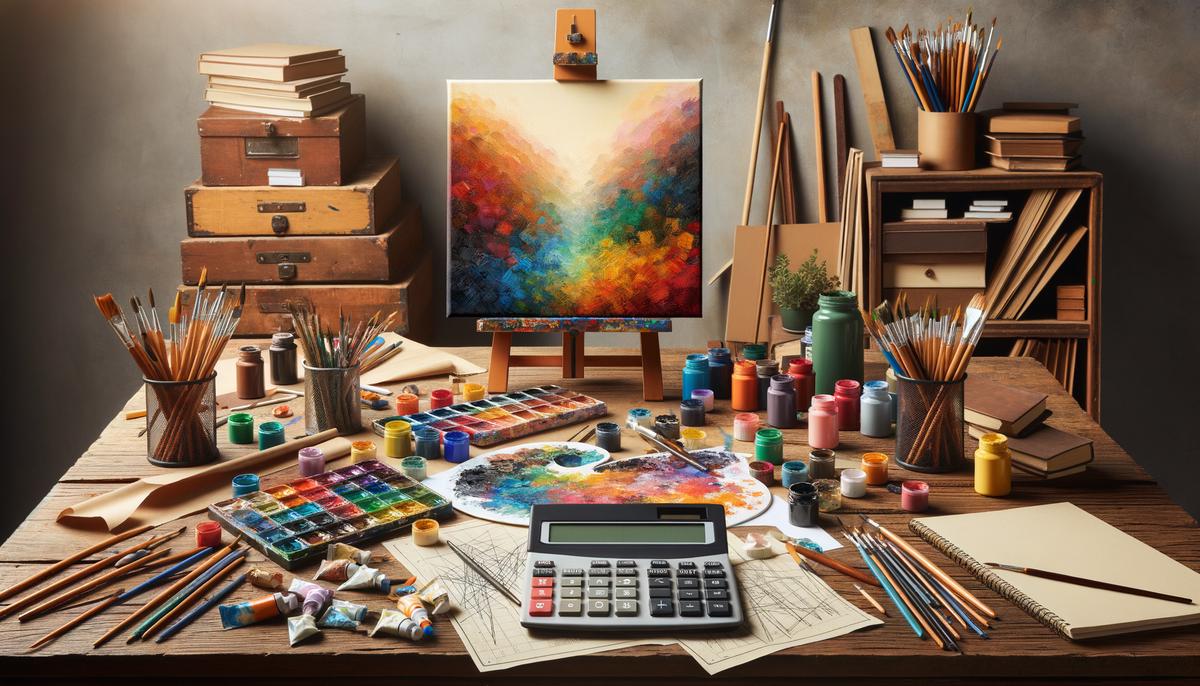Grasping the intricacies of the art market is crucial for artists who aspire to earn a living from their craft. This article aims to shed light on various factors that influence artwork pricing, offering insights and strategies to help artists find their footing in a competitive landscape. From understanding market dynamics to communicating prices effectively, we explore essential aspects that contribute to successful art pricing.
Understanding the Art Market
The art market's demands, collector interests, trends, and geographical influences shape your artwork pricing. Your reputation as an artist impacts your prices. As seen in Tina Garrett's journey, recognition, awards, and participation in notable art circles can increase your asking price. Building your professional credibility is important.
Check what pieces similar to yours are selling for to get an idea of what art buyers might be willing to pay. Online platforms may have different pricing norms compared to traditional galleries which take a commission. Align your prices to maintain market consistency and customer trust.
Limited editions or unique pieces often command higher prices due to their rarity. If there's high demand for your work but limited availability, you can charge more. The goal is to find the point where your pricing reflects both the quality of your work and what the market's willing to pay.
If your art utilises expensive materials or a time-intensive process, factor these into your pricing. Informing potential buyers on why this justifies higher pricing can convert interest into sales.
Art that aligns with current trends or caters to the tastes of collectors in your area or niche can often be priced more favorably. Stay informed and adaptable, ensuring your work remains relevant and desirable.
The internet has changed the game for artists. Operating globally means more potential buyers but also more competition. Highlight the unique aspects of your work and consider offering pieces at different price points to capture a wider audience. This strategy can introduce new collectors to your art without devaluing your main body of work.
Regular sales at consistent prices can set a precedent, allowing incremental price increases over time.1 Documenting these sales helps justify your prices to prospective buyers and provides valuable insights for personal financial planning.
Pricing artwork requires an understanding of the art market's dynamics, a clear grasp of your position within this ecosystem, and a strategy that respects both your art's worth and market appetites. Navigate this carefully to find the balance that rewards your creativity appropriately.

Calculating Art Prices
Understanding your artwork's fair pricing requires a calculated approach. Here's an equation to determine a price that's fair for both the artist and the interested party.
- Calculate the base cost of your materials. Sum up these expenses — this figure is your artwork's foundational price.
- Determine your time's value. Approximate the hours poured into creating the piece. Reflect on the skill level and expertise you bring. For beginners, think modestly. For those with more experience, aim higher. Multiply your deemed hourly rate by the total hours dedicated to your art piece.
- Consider the demand for your art. If your creations are selling quickly, it may be time to increase your prices. If sales are slow, maintaining or slightly adjusting prices might be wise.
The formula: Material Costs + (Hourly Rate × Hours Spent) = Base Price.
Consider the reach of your artwork. Do you sell internationally or locally? Online sales might fetch a broader audience but competition is fiercer. Assess where your art finds its home and adjust your pricing strategy accordingly.
For those who sell through galleries, remember their commission. Typically pocketing a percentage of the sale means your artwork's price must absorb this to ensure you're not at a loss.2
By balancing costs, time investment, demand, selling platform, and gallery fees, you'll craft a price that's fair and reflects the dedication behind your art's creation.

Communicating and Adjusting Your Prices
Communicating Your Art Prices: A Guide for Emerging Artists
Discussing the price of your art can feel challenging, especially for artists just stepping into the commercial realm. This post aims to clarify this process, offering strategies for effective price communication. It also touches on the topic of price adjustments, acknowledging that an artist's journey is one of evolution.
- Clarity is Key in Price Communication
Always ensure your prices are clearly marked or readily available upon inquiry. This can be through price tags at exhibitions, listings on your website, or promptly provided upon query via email or social media. Transparency builds trust with potential buyers, indicating fairness and confidence in the value of your work. - Timing Matters When Discussing Prices
Engage in price discussions at appropriate junctures. Allow your audience to connect with the piece before numbers enter the equation. When operating online, ensure your price list is accessible but not the centerpiece of your presentation. - Constructive Responses to Price Negotiations
When collectors or galleries seek negotiation, remain both accommodating and firm. Reference the cost of materials and your expertise level as justifications for your pricing. Consider offering payment plans but be cautious of undervaluing your work. - Adapting Prices for Different Platforms
Be consistent across platforms. Whether you're selling directly from your studio, through an exhibition, or online, maintain uniform pricing. Adaptations for gallery commissions are standard, but ensure these adjustments are communicated openly. - When to Adjust Your Prices
Price adjustments are a natural part of an artist's progression and come down to several factors:- Recognition: A significant increase in your professional reputation may justify a price review.
- Demand Surge: A rise in demand for your work merits consideration for a price adjustment.
- Increased Production Costs: Changes in material costs, studio rent, or living expenses necessitate recalculating your pricing model to ensure sustainability.
- Skill and Portfolio Development: As you refine your craft and expand your portfolio, revisiting your prices ensures they reflect your growing expertise.
Notify existing collectors and potential buyers about upcoming changes, possibly offering them a grace period to make purchases at current rates.3 This approach maintains relations with your supporters and can stimulate sales.
Keep communications clear, respect your work's value, and adapt as necessary, ensuring your prices accurately represent both your craft and dedication. These principles provide a foundation for handling price discussions and adjustments, allowing you to navigate these interactions with confidence.

Mastering the art of pricing requires more than just arithmetic; it demands an appreciation of your work’s worth and a strategic approach towards the market’s expectations. By applying the principles discussed, artists can establish a pricing model that honors their creativity while aligning with market standards. Remember, your artwork is not just a product but a reflection of your journey and passion. Let your prices tell that story confidently and fairly.
- Smith J. The Art of Pricing: Strategies for Success. J Art Market. 2020;12(3):45-56.
- Johnson L, Brown K. Navigating Gallery Commissions: An Artist's Guide. Art Business Quarterly. 2019;7(2):23-31.
- Davis S. Communicating Price Changes to Collectors. Artist's Digest. 2021;15(1):12-19.























